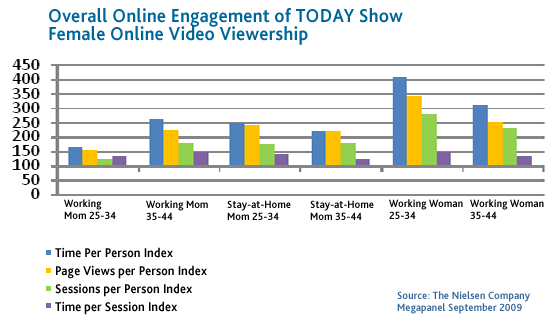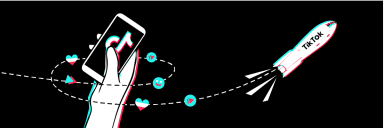Jessica Hogue, Research Director, online division and Karen Benezra, Vice President, Nielsen Life360
Download the webinar, How Women Connect With Online Video.
Consumption of online video content in the U.S. continues to skyrocket and women aged 25-44 are a major force behind the rapid adoption. Recently, Nielsen worked with TODAYshow.com to delve into the motivations and mindsets driving women’s video consumption. The study uncovered not only when, but how and why women use online video in their daily lives.
The study blended quantitative behavioral analysis with a qualitative lens to create a digital ethnography of TODAY’s online viewers, women aged 25 to 44, from across the country. This perspective allowed researchers to virtually observe women’s video viewing habits and to see and hear, in the women’s own words, what triggers their online behavior.
Four key themes stood out:
- Streaming among women is governed in large part by life stage and daily to-do lists, rather than age or employment status.
- Digital mindsets change over the course of the day and vary according to time, mood, location and “available mindshare.”
- The value of video as “social currency” is on the rise, leading some women to largely favor links suggested by friends.
- Emotional triggers impact viewing, specifically the types of content consumed.
“This research is incredibly powerful in giving us deeper insights into how our audience consumes online video,” said Jen Brown, Director of strategy and development for TODAYshow.com. “This type of research keeps us ahead of the trends, and that’s a clear advantage as we design new products and plan the launch of new features for both consumers and advertisers in the upcoming months.”
The Facts of Life
Life stage and occupation dictate online video habits – not just age.
While it is tempting to assume that younger women are propelling engagement, our study revealed that demographics are only part of the story.
Using women who have streamed TODAYshow.com as a proxy, Nielsen compared women’s overall online engagement to the average Internet population. It was plausible to think that stay-at-home women would have the highest Internet engagement. However, the study revealed that Internet use among working women with kids – a group that might otherwise have the least available time to spend online – was extremely strong. Moreover, women aged 35 to 44 had stronger digital activity – outpacing their younger counterparts in this category. This spike in activity revealed that workplace video consumption was much more common than originally expected.
Of the 35 women in this study, more than half reported watching video during the course of the day while at work. “When I watch video online, sometimes it’s to catch the end of a TV program that the DVR has cut off. Or maybe it’s financial videos,” said a 35-year-old respondent, who works as a paralegal. “We generally watch short videos anywhere from one minute to five minutes.”
Young Working Women are enormous consumers of entertaining content.

Plugged In
Digital mindsets for watching video change dramatically throughout the day.
Clicking on links to watch videos happens multiple times a day as women “snack” frequently on different types of digital content.
In the morning, women are regimented with a strong sense of purpose and information gathering. Often before they even get out of bed, women go online to check news, weather, stocks and personal “news” via social networks and email, utilizing bookmarks and other tools to make their online time as efficient as possible.
As the day evolves, entertaining and functional content (think how-to videos) occupies more mindshare. Coupon sites and online shopping typically vied with games and recipe hunts among study panelists as late afternoon pursuits. For non-workers, large chunks of time are devoted to searching for deals or collect-and-win points for grocery and other household items. “I am a couponer…I love to save money,” declared a 28 year-old respondent in the study. “I don’t know if that makes me cheap, but I will spend all day long [couponing] until my husband gets home.”
When the stress of the day starts to deplete their energy, women frequently seek out inspirational video content that brings meaning to their day and engages them.
Share and share alike
Social pass along for online video is high.
In August 2010, more than 25 million women streamed videos from social media platforms, up nearly 50% from the previous year. With a raft of new offerings enabling consumers to connect big TVs to the Web, it’s more important than ever to understand the drivers of watching video a la carte and on demand.
The study revealed that where women get content is critical. The 50% spike in streamed videos from social sites last August — which spans jokes and entertaining news content to video of a child’s piano recital — indicates the power of links shared by women with family and friends. Women are also much heavier consumers of video through social sharing sites, over-indexing by 11% compared with their male counterparts.
For some women, links sent by friends were considered to be of “higher value” since they are trusted sources, compared to blanket emails from unknown sources which are often associated with online scams and phishing.
Laughter is the best medicine
Emotional triggers play a significant role in video viewing.
Another key finding was that emotional triggers such as the need to relieve stress, boredom and feelings of loneliness contributed greatly to overall video consumption – but more specifically drove women to seek out “happy” and uplifting content. While these women over-index for consumption of digital news content, when it comes to video, they are more compelled to seek out absorbing, entertaining news content (time-shifted TV, movies, funny videos). To escape the stress of the work day, women turn to surfing, looking at videos of cute animals, reading jokes and other “happy things.” These online activities balance out their day and contribute to their overall sense of well-being.
It is important to note that a significant amount of this content was streamed midday at work (either in the background or when they had free pockets of time), or in the late night dayparts. “It’s nice to have an online venue where you can sort of enjoy it and not think too much,” said a busy working mom of two about her typical “wind-down” routine.
The behavioral analysis indicated that women across all segments were streaming more entertainment-related content than anything else. Current data shows that women aged 25 to 54 allocate 76% of their total streams to entertainment content.
Shop ’til you drop
Online advertising can be entertainment.
Women are often regarded as chief household purchasers. For brand marketers, connecting with this engaged audience is an alluring proposition and advertisers will need to go beyond the basics when trying to reach this audience. Including this demographic target in brand outreach is just the first step. Marketers will need to develop attention-grabbing creative and salient, impactful messages that can be delivered in online video in order to truly engage this audience.
The women in the survey were pragmatic about the price of flexible, free content.
“I think it’s only fair that there be advertising online. As we increasingly move toward finding the bulk of our entertainment there, products, services and companies need a way to reach consumers,” reasoned a 27 year-old, single respondent. “I don’t mind the commercials because they are few and tend to be fairly entertaining themselves. A well-crafted commercial can be a thing of beauty and I am a very susceptible target for anything new that looks cool or at least has some great packaging.”


